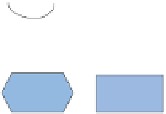Information Technology Reference
In-Depth Information
•
As a particular case of this situation, which are the conditions that indicate that a
model is completely refined.
In some particular situation, what
i
∗
modelling element is the most adequate.
A typical example is: when a task produces a resource, which element must be
included: just the task, just the resource, none, or both.
•
Given an answer as accurate as possible to these and similar questions is the only
way to overcome the modelling uncertainty problem.
Challenge.
The
i
∗
community shall have available a range of well-defined
modelling methods as predictable as possible.
State of the art.
The construction of goal-oriented models in general has been
subject of interest by the requirements engineering community, for instance Rolland
et al. used explored the use of scenarios to drive the discovery of goals [
56]
. The
need of modelling methods for the
i
∗
framework became obvious soon and a major
response was the formulation of the Tropos method [
7]
. Tropos spans four phases of
software development, namely early requirements, late requirements, architectural
design and detailed design, previous to implementation (in some papers considered a
fifth phase) using some agent-oriented infrastructure. The method is not prescriptive
inside these four phases and then the modeller still has a great freedom in completing
the model. In [
27]
, the authors propose the use of social patterns as a way to elicit
the general structure of models. However, still the patterns just provide a general
layout of the models.
Other authors propose more detailed methods. In [
22]
the R
i
SD methodology is
proposed for the modelling of Strategic Dependency (SD)
i
∗
diagrams. It is orga-
nized into several steps, and intents to be a highly prescriptive procedure. As part
of the steps, we may mention: (a) The formulation of two alternative decision trees
(under dependum's nature and under responsibility assignment strategy) for deter-
mining the most appropriate type of intentional element in a given situation (see
Fig.
2)
, where the transition of one node to a child is based on a question (e.g., in
1
2
OR
3
I
State
Entity
OR
4
OR
OR
5
6
II
III
IV
V
Criteria
Task
Resource
Task
Soft Goal
Resource
Goal
OR
7
8
9
10
VI
IX
Soft Goal
VII
VIII
Goal
Soft Goal
Soft Goal
Soft Goal
Soft Goal
Soft Goal
Soft Goal
11
12
Soft Goal
Soft Goal
Fig. 2
Decision trees for determining the type of intentional element as defined in [
22]
























Search WWH ::

Custom Search